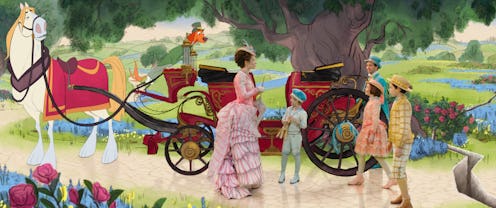Entertainment
These Are The Mary Poppins Books You Should Read Before The Sequel Comes To Theaters

Disney is rife with reboots, but Mary Poppins Returns is decidedly a "sequel, not a remake" — as Lin-Manuel Miranda's Twitter is eager to remind fans. Not only that, but it's based on books you can check out from the library right now, if you want. Mary Poppins Returns adapts P.L. Travers' other tales about the famous flying nanny to tell a brand new story.
"P.L. Travers wrote eight books throughout the course of her life," director Rob Marshall says in a Q&A shared with reporters. "So there was so much material. The second book was called Mary Poppins Comes Back, and then there was one called Mary Poppins Opens the Door, and Mary Poppins in the Park."
It may seem as though the new adventures are trying to recreate the magic of the 1964 film: Returns has an animated sequence, a song featuring men dancing in newsie caps, and a bizarre Poppins relative, all just like the original Mary Poppins. But the creative team is actually going even further back and digging into stories that have been hiding in plain sight on bookshelves for decades.
All of those Mary Poppins books are still in print, by the way. In the new film, Meryl Streep's character Topsy and Angela Lansbury's Balloon Lady are adapted from Mary Poppins Comes Back, and so is the scene in which the Banks children jump into a Royal Doulton Bowl.
In this new featurette, you can see how reverent and enthusiastic the stars and director are about this legendary source material:
"We went back to the source," producer Marc Platt tells press visiting the film set. "What we found in the rest of those eight books was really a treasure trove of wonderful episodes and new characters and it really opened up a whole new world of Mary Poppins to us."
Walking around set and learning about these fantastic characters and adventures really made me want to pick the books up and see for myself. Because even dedicated fans of the original movie might not be aware of how much more Mary there is in print. Production designer John Myhre was particularly thrilled about how the books set a challenge for him as an artist. "I hadn’t read any of the books since I was 7 years old," Myhre says, "and I found myself as a 50-year-old man sitting in the airport reading Mary Poppins books, getting very strange looks, but they’re terrific!"
He dug into the books for clues as to what different sets should look like. "What was amazingly fun for me," he tells us, "it said that on the first Monday of every month [Topsy's] entire house turns upside down." He also found a working 1930s Ferris Wheel for another sequence.
The possibility of making a sequel from these other books was floated by Disney producers in the '80s, the director says, but never got off the ground. If you've seen Saving Mr. Banks, the 2013 film about the writing process behind the first Mary Poppins film, you have some idea of why that may have been contentious.
"As we famously know," Marshall explains, "P.L. Travers was very protective of the material so [a sequel] was always very difficult to try and make happen." Still, Marshall said, "throughout those eight books you see that theme, this sense that adults forget the joys of childhood. I know she was considered — I didn't know her obviously — a tough lady, but I think she really understood child-like wonder."
It's easy to feel jaded by sequel/reboot/remake fever, but the production team behind the new Mary Poppins really put the work in to make sure they were telling this story at the right time and for the right reasons. "You look at iconic characters like James Bond," Marshall says, "who have been reimagined so many times over the years with the different novels and even a Star Wars film that has so many layers and so many characters, how they began and where they are now."
While we don't see Marshall on set because he's busy directing a complicated dance number, I get the sense that his own child-like wonder may not be dissimilar from Travers. "Rob doesn’t like straight [lines]," Myhre says, "because curved is more musical." That's why the infamous Cherry Tree Lane has that whimsical, "serpentine" shape, according to the designer.
How many other references, Easter Eggs if you will, and/or characters from Travers' work will pop up in Mary Poppins Returns? The prospect of an adaptation that takes a character you know and tells stories you may not is so exciting... but there's still time to pick up those other books before the movie's Dec. 19 release.